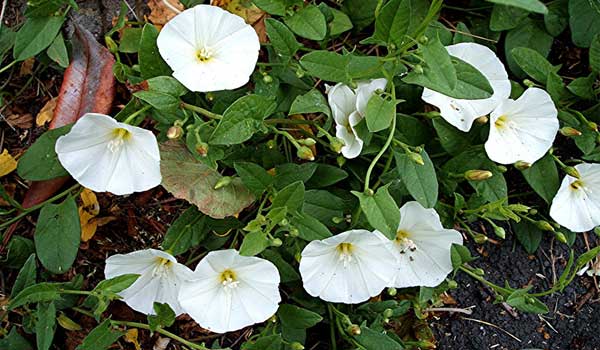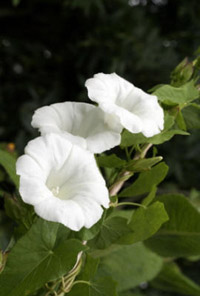
In Bindweed Control, Better Early Than Late
Oregon State University weed scientist Ed Peachey didn’t set out to research bindweed control strategies in blueberries, but he’s been doing so for several years.
That’s the way it is when you’re researching bindweed, he said.
“The funny thing is, as soon as you start working with bindweed, then bindweed starts showing up everywhere,” Peachey said at the 2015 Oregon Blueberry Conference, held January 27 in Portland.
Peachey said he first discovered bindweed in a rhubarb field near Canby, Oregon.
“Then, across the road, I noticed bindweed was becoming a real headache in this Marionberry field,” he said, “so I began working in small fruits. Then I started working in blueberries.”
At the conference, Peachey provided participants some of the latest information on strategies for controlling the perennial broadleaf.
One strategy stood out as perhaps the most important when looking to control the problematic weed.
Because the weed can produce extensive underground root structures, controlling it as a seedling is vital.
“You want to go after it when it is a seedling, before it develops a big root system,” Peachey said.
The weed has two main species, field and hedge bindweed, both of which can reproduce from underground roots and from seed, he said.
Peachey said he has researched the efficacy of several herbicides on the weed, some of which are not yet registered for use in blueberries.
 One that is not yet registered for use in blueberries is Quinclorac, a post-emergence material that has shown good efficacy on the weed, both when applied as a split application separated by twenty to thirty days, with the first application in mid-April, and as a single-shot application, also applied in mid-April. One that is not yet registered for use in blueberries is Quinclorac, a post-emergence material that has shown good efficacy on the weed, both when applied as a split application separated by twenty to thirty days, with the first application in mid-April, and as a single-shot application, also applied in mid-April.
The single application method at a twelve-ounce rate “held all the way to harvest,” Peachey said, and the split application of six ounces each “provided exceptional bindweed control.”
Quinclorac also picks up lambsquarter, bed straw, prickly lettuce and sunflower,” he said. “It has a very odd weed-control spectrum.”
The product has been registered in cranberries as Quinstar. Researchers are hoping it will be registered in blueberries in 2016.
“Residue studies are completed and at IR-4, and the package is ready for submission to EPA,” Peachey said.
Peachey also provided information on studies he’s conducting on biological controls of bindweed, none of which “are working all that well,” he said.
Among biological controls being tested, one is looking at a moth that feeds on the weed. The bindweed moth “has a voracious appetite,” Peachey said. “Put it on bindweed and it eats it to the ground.”
Keeping the moth in a field where bindweed is present, however, has proven difficult.
“It tends to take off when you let it go,” Peachey said. “It gets dispersed very widely.”
Peachey also provided information on research he’s conducted in pre-emergence herbicides, including Callisto, Chateau and Zeus.
“One thing to remember about Zeus and Chateau,” he said, “is they have a little bit of post-emergence activity, and if used improperly, you can get some severe burning of younger canes.”
In fact, both products carry restrictions to not apply to blueberries established less than two years, in the case of Chateau, and three years in the case of Zeus.
Also, Peachey said, Chateau and Zeus are contact herbicides that intercept a weed seeding as it comes to the soil. “They don’t work on roots and shoots underground,” he said. “Not until the plant exposes itself does the herbicide go to work.”
Peachey advised growers to incorporate the herbicides slightly into the soil profile so they can create a barrier against target weeds. Maintaining that protective barrier by not disturbing the soil also is important, he said.
Peachey also provided information on flazasulfuron, a pre-emergence herbicide that he says “has some potential.”
It currently is not labeled in blueberries, but is in wine grapes in Oregon and California, where it is sold under the brand name Mission by Summit Agro.
“It has a fairly good environmental profile,” he said. “It typically is labeled on older plantings.”
The product has a 75-day pre-harvest interval. “It does have some longevity in the soil, which is one drawback,” he said.
Peachey said there is interest in registering the product, but he is unsure if the manufacturer will seek the registration in blueberries.
“I think it could fill an important niche in our toolbox,” he said.
In general, Peachey said it is vital to control bindweed before planting a field to blueberries.
“A year before you plant blueberries there is a lot of opportunity to take care of bindweed,” he said. “After you get the first-year plants in there, your opportunity is really limited and will be limited for a long time.
“Many of the products I am looking at can’t be applied until two and three years after planting,” he said.
“You start with a clean field and avoid following perennial crops, particularly low- or no-tillage sites,” he said. “Also, bindweed flourishes in mint crops, so you want to make sure you don’t drop into a field where mint was common.
“And you don’t want to introduce seeds from your equipment or plant parts that you are moving from one field to another,” he said.
“We need to focus on not only herbicides, but cultural controls, as well,” he said.
More information on controlling bindweed is available in the Pacific Northwest Weed Handbook at pnwhandbooks.org/weed.
|
